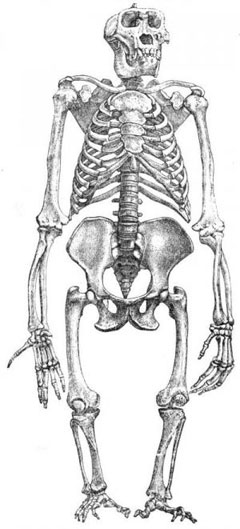Ancient humanoids were short for fighting, not climbing
Ancient humanoids were short and nasty for kung fu fighting, not climbing
mongabay.com
March 12, 2007
Ancient ape-like human ancestors called as australopiths were short-legged to help them fight, not to climb trees, argues a new study from a researcher at the University of Utah.
“The old argument was that they retained short legs to help them climb trees that still were an important part of their habitat,” said David Carrier, a professor of biology at the University of Utah. “My argument is that they retained short legs because short legs helped them fight.”
The study, published in the March issue of the journal Evolution, analyzed leg lengths and indicators of aggression in nine primate species, according to a release from the university.
Carrier says that Australopiths, which lived between four and two million years ago, had heights of about 3 feet 9 inches for females and 4 feet 6 inches for males, but until now it was unclear why their short stature would be an advantage.
“For that entire period, they had relatively short legs — longer than chimps’ legs but shorter than the legs of humans that came later,” Carrier stated.

University of Utah biology Professor David Carrier’s new study concludes that human ancestors known as australopiths retained short legs during their 2-million-year history because a short, squat stature helped spell victory in male-male fights over females. Photo Credit: Nadja Schilling
This drawing of a male gorilla skeleton illustrates their very short legs. Male gorillas fight to gain access to reproductively mature females. Relatively short legs increase the stability and strength of great apes, and should therefore increase fighting performance. A new University of Utah study suggests human ancestors known as australopiths had short legs for the same reason, not just for climbing trees. Credit: From Alfred Brehm, “Brehms Tierleben” (“Brehm’s Life of Animals”), small edition, 1927. |
“So the question is, why did australopiths retain short legs for 2 million years? Among experts on primates, the climbing hypothesis is the explanation. Mechanically, it makes sense. If you are walking on a branch high above the ground, stability is important because if you fall and you’re big, you are going to die. Short legs would lower your center of mass and make you more stable.”
Carrier’s research shows that short legs helped Australopiths fight better.
“With short legs, your center of mass is closer to the ground. It’s going to make you more stable so that you can’t be knocked off your feet as easily. And with short legs, you have greater leverage as you grapple with your opponent.”
He adds that there is little evidence that short legs would have helped climbing, noting “the apes that have the shortest legs for their body size spend the least time in trees — male gorillas and orangutans,” but says that the adaptations for the two specializations are not mutually exclusive.
“The two hypotheses for the evolution of relatively short legs in larger primates, specialization for climbing and specialization for aggression, are not mutually exclusive,” he wrote. “Indeed, selection for climbing performance may result in the evolution of a body configuration that improves fighting performance and vice versa.”
Comparing Australopiths to modern-day primates with known levels of aggressiveness, Carrier found a correlation between hindlimb length and male-on-male combat.
“If it is mainly the males that need to be adapted for fighting, then you’d expect them to have shorter legs for their body size,” he said, but cautioning that “we [still] don’t really know how aggressive australopiths were. If they were more aggressive than modern humans, they were exceptionally nasty animals.”
Carrier says his research may help explain the origins for aggression in modern humans.
“This is important because we have a real problem with violence in modern society. Part of the problem is that we don’t recognize we are relatively violent animals. Many people argue we are not violent. But we are violent. If we want to prevent future violence we have to understand why we are violent.”
“To some extent, our evolutionary past may help us to understand the circumstances in which humans behave violently,” he concluded. “There are a number of independent lines of evidence suggesting that much of human violence is related to male-male competition, and this study is consistent with that.”
This article quotes extensively from a news release from the University of Utah.
